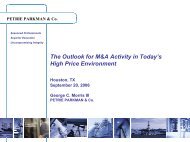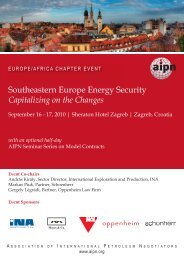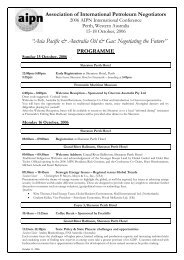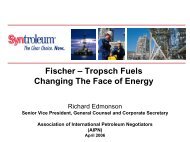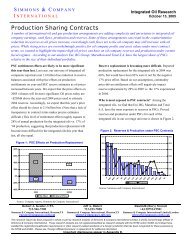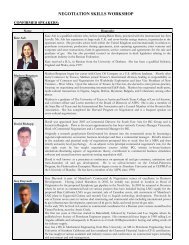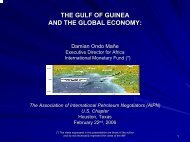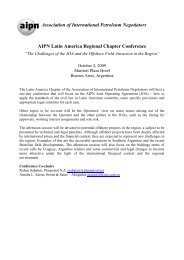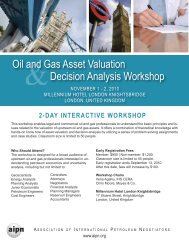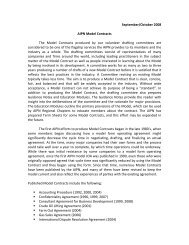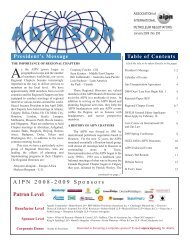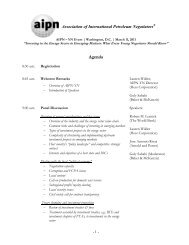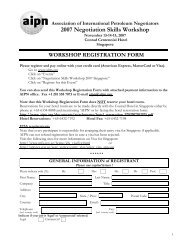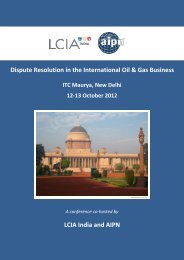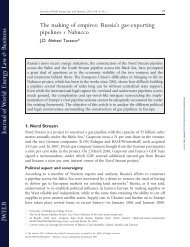ADVISOR - AIPN
ADVISOR - AIPN
ADVISOR - AIPN
Create successful ePaper yourself
Turn your PDF publications into a flip-book with our unique Google optimized e-Paper software.
Eased Sanctions<br />
Widen Doorway<br />
to Myanmar Oil<br />
and Gas Sector<br />
Michael Arruda, Partner, Jones Day, Hong Kong*<br />
On July 11, 2012, the United States formally eased certain<br />
sanctions relating to “new investment” in the Union of<br />
Myanmar (“Myanmar”) and on the exportation of financial<br />
services to Myanmar. 1 This change in the scope of the Burmese<br />
Sanctions Regulations, 2 implemented by General License Nos. 16<br />
and 17 and issued by the U.S. Department of the Treasury's Office<br />
of Foreign Assets Control (“OFAC”), will allow, under certain<br />
circumstances, U.S. individuals and entities to invest in Myanmar's<br />
oil and gas sector for the first time in 15 years.<br />
The decision to ease sanctions was presaged by<br />
announcements by President Barack Obama and Secretary of State<br />
Hillary Clinton in May of this year and followed the announcement<br />
in April by the Council of the European Union that it was<br />
suspending the majority of the EU’s separate, multilateral<br />
sanctions program in respect of Myanmar for a period of one year. 3<br />
Australia, Canada, and Norway also significantly eased their<br />
respective sanctions against Myanmar, and Japan announced that<br />
it planned to forgive some $3.7 billion of Myanmar’s debt and<br />
resume full-fledged development aid as a way to support the<br />
country's democratic and economic reforms.<br />
This article will focus on the impact of General License No. 17<br />
SEPTEMBER 2012 • 26<br />
EDUCATION<br />
(“GL-17”) on investments in the Myanmar oil and gas sector,<br />
including areas in which the sanctions regime has been<br />
unaffected. 4<br />
Myanmar Sanctions regime<br />
Since 1990, the United States has imposed an array of trade<br />
sanctions and restrictions against Myanmar, which derive from<br />
various federal laws 5 and Presidential Executive Orders that are<br />
now codified in the Burmese Sanctions Regulations. 6 Some<br />
sanctions that initially arose out of Executive Orders have persisted<br />
by way of extensions granted through presidential proclamations<br />
under the International Emergency Economic Powers Act of 1997, 7<br />
which allows the U.S. President to extend certain sanctions where<br />
a national emergency finding is made. The key prohibition that<br />
affected the oil and gas sector has been the prohibition on “new<br />
investments,” which is found in 31 CFR § 537.204 and originated<br />
in Executive Order No. 13047 issued by President Bill Clinton on<br />
May 20, 1997. It is an interesting turn of fate that President Obama<br />
delegated to Secretary of State Hillary Clinton the authority to lift<br />
the ban imposed by an Executive Order issued by her husband 15<br />
years earlier.<br />
Taken together, these federal laws and Executive Orders<br />
cumulatively have precluded virtually all commerce between the<br />
U.S. and Myanmar since 1997. In addition to prohibiting “new<br />
investments” 8 in Myanmar, the Burmese Sanctions Regulations<br />
also prohibited, among other activities, the exportation or reexportation<br />
of financial services to Myanmar from the U.S.; 9 the<br />
importation into the U.S. of any “products of Burma”; the<br />
facilitation, for example through financing or guaranteeing, of any<br />
prohibited transactions; and attempts to evade or avoid the<br />
prohibited activities. 10 The Burmese Sanctions Regulations also<br />
nullified transactions with certain Specially Designated Nationals<br />
and blocked their accounts. Exemptions included activity pursuant<br />
to an agreement in place before May 21, 1997, personal<br />
communications, distribution of information materials, or<br />
personal travel to Myanmar.<br />
Prominent among the industries affected by the Burmese<br />
* Author’s Note<br />
The author would like to thank his fellow lawyers at Jones Day for their assistance in the preparation of this article, including Michael Gurdak, Ben McQuhae, Dominic Johnson, Joanne Du,<br />
Edith Ho and others who assisted with its editing. This article originally appeared as a Jones Day Commentary in August 2012, and the copyright is held by Jones Day. Jones Day publications<br />
should not be construed as legal advice on any specific facts or circumstances. The views set forth herein are the personal views of the author and do not necessarily reflect those of the Firm.<br />
Endnotes<br />
1 General License No. 16 and General License No. 17 issued by the Office of Foreign Assets Control, Department of the Treasury (“OFAC”) on July 11, 2012; Executive Order 13619, "Blocking<br />
Property of Persons Threatening the Peace, Security or Stability of Burma,” 77 Federal Register 41243-41245 (July 11, 2012).<br />
2 The Burmese Sanctions Regulations were codified in 2005 in Title 31, Part 537 of the Code of Federal Regulations.<br />
3 See Council Decision 2012/225/CFSP 2012 O.J. (L 115/25) (April 26 2012) (available at http://eur-lex.europa.eu/LexUriServ/LexUriServ.do?uri=OJ:L:2012:115:0025:0026:EN:PDF).<br />
4 In this article, we refer to the Union of Myanmar as “Myanmar,” except where the U.S. documents lifting the ban or explaining it or the Burmese Sanctions Regulations refer to "Burma," in<br />
which case we use the nomenclature utilized in those documents.<br />
5 Customs and Trade Act of 1990 (P.L. 101-382); Foreign Assistance Act of 1961 (P.L. 87-195); Foreign Operations, Export Financing, and Related Programs Appropriations Act of 1997 (P.L. 104-<br />
208); Burmese Freedom and Democracy Act of 2003 (P.L. 108-61); and Tom Lantos Block Burmese JADE (Junta's Anti-Democratic Efforts) Act of 2008 (P.L. 110-286).<br />
6 Executive Order 13047, “Prohibiting New Investment in Burma,” 62 Federal Register, 28301-28302 (May 20, 1997); Executive Order 13310, "Blocking Property of the Government of Burma<br />
and Prohibiting Certain Transactions,” 68 Federal Register, 44853-44856 (July 28, 2003); Executive Order No. 13448, “Blocking Property and Prohibiting Certain Transactions Related to<br />
Burma,” 72 Federal Register, 60223-60226 (October 18, 2007); and Executive Order 13464, “Blocking Property and Certain Transactions Related to Burma,” 73 Federal Register, 24491-24493<br />
(April 30, 2008).<br />
7 P.L. 95-223.<br />
8 The term “new investment” is defined at 31 CFR § 537.311.<br />
9 Concurrently with the issuance of GL-17, OFAC issued GL-16, which authorizes “the exportation or re-exportation of financial services to Burma, directly or indirectly, from the United States<br />
by a U.S. person, wherever located….” General License No. 16, issued July 11, 2012.<br />
10 31 CFR 537, Subpart B–Prohibitions.



